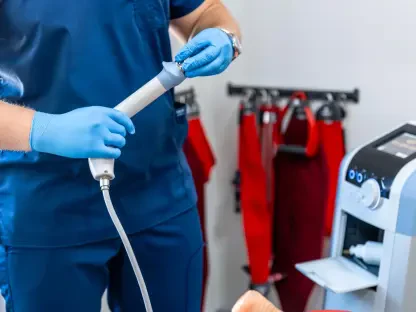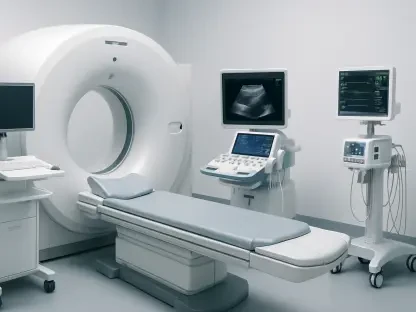In the intricate world of medical diagnostics, spinal infections such as Brucella spondylitis (BS) and tuberculous spondylitis (TS) present a formidable challenge due to their strikingly similar clinical symptoms and imaging profiles. These conditions, though distinct in their treatment requirements, often baffle even seasoned clinicians because standard diagnostic tools like conventional magnetic resonance imaging (MRI) struggle to differentiate them with precision. Misdiagnosis or delayed identification can lead to improper therapies, potentially exacerbating patient suffering and prolonging recovery. Enter deep learning, a transformative subset of artificial intelligence (AI), which is reshaping the landscape of medical imaging. A recent groundbreaking study has introduced an AI-driven model designed to analyze MRI scans with unprecedented accuracy, offering a lifeline in distinguishing between BS and TS. This innovation not only promises to streamline clinical decision-making but also underscores the immense potential of technology to address long-standing diagnostic dilemmas, ultimately enhancing patient care on a global scale.
Unraveling the Diagnostic Puzzle of Spinal Infections
The diagnostic conundrum surrounding BS and TS stems from their overlapping manifestations, which can mislead even the most meticulous medical evaluations. Both infections target the spine, presenting with comparable pain patterns and imaging characteristics that often blur the lines between them. Conventional MRI, a cornerstone in spinal assessments, frequently falls short in detecting the nuanced differences necessary for a definitive diagnosis. This ambiguity can result in delayed or incorrect treatments, risking severe complications for patients. The urgency for a more reliable diagnostic approach cannot be overstated, as timely identification directly impacts therapeutic success. Traditional methods, including microbiological tests, add further delays due to their time-intensive nature, highlighting a critical gap in current clinical practices that technology is poised to bridge with innovative solutions.
Moreover, the consequences of diagnostic uncertainty extend beyond individual patient outcomes to broader healthcare challenges. When spinal infections are misidentified, resources are wasted on ineffective interventions, and patient trust in medical systems may erode. The need for a tool that can swiftly and accurately distinguish between these conditions is paramount, especially in regions where access to advanced testing is limited. Deep learning emerges as a beacon of hope in this scenario, leveraging computational power to analyze vast amounts of imaging data with a level of detail unattainable by human observation alone. By addressing these diagnostic hurdles, such technology offers a pathway to more efficient healthcare delivery, ensuring that patients receive the right care at the right time, regardless of geographic or economic barriers.
Revolutionizing Imaging with Deep Learning Technology
Deep learning stands at the forefront of a technological revolution in medical imaging, offering capabilities that far exceed traditional diagnostic methods. By training algorithms on extensive datasets of MRI scans, this branch of AI can detect subtle patterns and anomalies that often escape human scrutiny. In the context of spinal infections, a pioneering model based on the ResNeXt-50 architecture, augmented by the Convolutional Block Attention Module (CBAM), has been developed to focus on critical areas within images. This mechanism enhances the model’s ability to discern minute differences between BS and TS, achieving an extraordinary accuracy rate of over 94%. Such precision marks a significant leap forward, providing clinicians with a tool that not only supports but elevates their diagnostic expertise.
Beyond raw accuracy, the implications of this deep learning model are profound for clinical efficiency. Unlike other AI frameworks that may require specialized imaging protocols, this model operates effectively with standard MRI data, specifically sagittal T2-weighted sequences. Its superior performance compared to other architectures like ResNet50 or VGG16 underscores the tailored design that prioritizes diagnostically relevant features. This technological advancement translates to fewer diagnostic errors, enabling healthcare providers to initiate targeted treatments much sooner. For patients grappling with the debilitating effects of spinal infections, this means a faster path to recovery and a reduced risk of long-term complications. As deep learning continues to evolve, its integration into medical imaging heralds a new era where technology and human skill converge to redefine diagnostic standards.
Bridging Accessibility with Standard MRI Tools
A remarkable strength of the deep learning model lies in its compatibility with conventional MRI technology, which is already a staple in hospitals worldwide. By utilizing sagittal T2-weighted sequences—a common imaging technique for spinal evaluations—the model ensures that its benefits are not confined to high-end medical facilities with cutting-edge equipment. This strategic choice democratizes access to advanced diagnostics, allowing even resource-constrained clinics to adopt this AI-driven approach without significant infrastructural investments. The ability to integrate seamlessly into existing clinical workflows enhances the model’s practicality, making it a viable solution for diverse healthcare environments, from bustling urban hospitals to remote rural centers.
Furthermore, the focus on widely available MRI technology addresses a critical barrier in global healthcare equity. In many regions, advanced diagnostic tools remain out of reach due to financial or logistical constraints, leaving patients vulnerable to prolonged diagnostic uncertainty. By leveraging a tool as ubiquitous as conventional MRI, the deep learning model offers a scalable solution that can impact patient care on an international scale. This accessibility fosters a more inclusive approach to medical innovation, ensuring that the advantages of AI are not limited to privileged settings but extend to underserved populations. As a result, the model not only enhances diagnostic accuracy but also contributes to a more equitable distribution of cutting-edge healthcare solutions, paving the way for broader systemic improvements.
Transforming Clinical Outcomes with Rapid Diagnosis
The clinical implications of deploying a deep learning model for spinal infection diagnosis are transformative, particularly in terms of speed and precision. Differentiating between BS and TS has historically required a combination of imaging, invasive procedures, and time-consuming laboratory tests, often delaying critical interventions. This AI-powered tool circumvents these hurdles by providing a non-invasive, image-based solution that delivers results with remarkable swiftness. With an accuracy rate exceeding 94%, clinicians can rely on the model to make informed decisions promptly, ensuring that patients receive the appropriate treatment without unnecessary delays. This rapid diagnostic capability is especially crucial in severe cases where timely action can prevent irreversible damage.
Additionally, the reduction in diagnostic turnaround time has a ripple effect on overall patient management. Faster identification of the specific infection allows for earlier therapeutic interventions, which can significantly mitigate the risk of complications such as chronic pain or spinal deformities. The model’s ability to streamline the diagnostic process also alleviates pressure on healthcare systems by optimizing resource allocation—fewer redundant tests and shorter hospital stays translate to cost savings and improved efficiency. For patients, the emotional and physical burden of uncertainty is lessened, fostering greater confidence in medical care. This deep learning application exemplifies how technology can directly enhance clinical outcomes by addressing longstanding inefficiencies in the diagnostic pipeline.
Ensuring Trust Through Rigorous Validation
Confidence in any new medical technology hinges on its proven reliability across varied real-world scenarios, and this deep learning model has undergone extensive validation to meet such standards. Tested with both internal cohorts and external patient groups from different hospitals, the model demonstrated consistent performance regardless of population diversity or imaging system variations. This rigorous evaluation process, which included assessing precision and recall metrics alongside an area under the curve (AUC) score above 0.95, confirms the tool’s robustness. Such comprehensive validation is essential for assuring healthcare providers that the technology can be trusted in dynamic clinical environments where patient profiles and equipment standards differ widely.
Equally important is the transparency and generalizability that this validation process brings to the table. By ensuring the model performs effectively across multiple settings, the study addresses potential concerns about bias or overfitting that often plague AI tools. The external validation, in particular, highlights the model’s adaptability to diverse healthcare contexts, reinforcing its potential for widespread adoption. This level of scrutiny not only builds trust among medical professionals but also sets a benchmark for future AI developments in diagnostics. As clinicians increasingly look to integrate such technologies into their practices, the assurance of reliability provided by thorough testing becomes a cornerstone for acceptance, ensuring that patient care benefits from innovation without compromising on safety or accuracy.
Envisioning AI’s Broader Role in Healthcare
The successful application of deep learning in diagnosing spinal infections reflects a larger trend in healthcare toward embracing AI to tackle complex challenges. This model’s ability to enhance MRI analysis for BS and TS serves as a compelling case study for how computational tools can augment human expertise across various medical domains. From interpreting intricate imaging data to predicting disease progression, AI is increasingly positioned as a partner in precision medicine, offering insights that refine clinical decision-making. The high accuracy and accessibility of this particular model suggest a future where such technologies become integral to routine care, addressing diagnostic gaps that have long hindered effective treatment.
Looking ahead, the impact of AI in healthcare extends beyond individual tools to systemic transformation. The emphasis on using conventional MRI ensures that innovations are not confined to elite institutions but can benefit a global patient base, promoting equity in medical advancements. This study also sets a precedent for applying similar deep learning approaches to other conditions with diagnostic ambiguities, potentially revolutionizing fields like oncology or neurology. As research progresses, the integration of multi-modal data—combining imaging with clinical and laboratory inputs—could further enhance diagnostic precision. Ultimately, the journey of AI in healthcare points toward a collaborative future where technology and human insight work hand in hand to elevate patient outcomes across diverse medical landscapes.









